Finally, Buckingham Palace is in the final stretch of preparation for King Charles III's historic Coronation tomorrow, May 6, 2023. His wife, Camilla, the Queen Consort, will also be crowned with him.
It would be the highlight of royal pageantry the world will ever witness in recent memory as it is the only Coronation Ceremony of a Crown Head since 1953. The splendid highlight of royal pageantry.
 |
| Coronation portrait of Queen Elizabeth II and Prince Philip in 1953 |
The last time the world had witnessed a Coronation of a Monarch was in June 1953, almost 70 years ago, when the young Queen Elizabeth II was crowned as the first Queen of the House of Windsor. It was also the first time that the Coronation of a British Sovereign was televised.
 |
| Emblem of King Charles III stitched on the Robes of State |
As with most royal spectacles, the Coronation of a British monarch accompanies many traditions and historic regalia. Apart from the St. Edward Crown, which will be used to crown King Charles III, there are other Crown Jewels, Robes, and royal elements that are part of the ceremony.
Here are the Crown Jewels during the King and Queen's Coronation and the personalities who will carry the jewels during the procession.
The Transport
First, the King and Queen will be transported via a Diamond Jubilee coach, from Buckingham Palace to Westminster Abbey. It is a six-horse-drawn carriage originally made for Queen Elizabeth II's 80th birthday in 2006 but was completed only in 2012 in time for her Diamond Jubilee celebration.
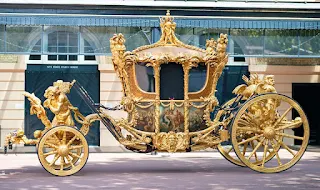 |
| Diamond Jubilee coach |
From Westminster Abbey to Buckingham Palace after the Coronation, King Charles and Queen Camilla will travel on a Gold State Coach, an enclosed eight-horse-drawn carriage originally made in 1760 for King George III.
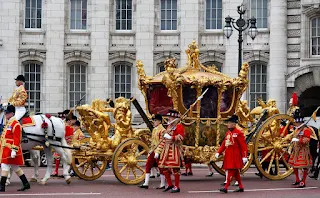 |
| Gold State Coach |
The Gold State Coach has been used at the Coronation of every British monarch since King William IV. It is one of the most splendid royal coaches used in Europe today.
 |
| Gold State Coach |
It is a gilded coach featuring panels by Giovanni Battista Cipriani, and a rich gilded sculpture including three cherubs on the roof and four tritons.
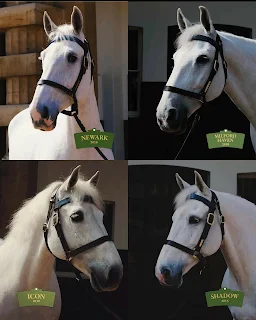 |
| The Windsor Grey horses that will pull the Gold State Coach ©The Royal Family |
 |
| The Windsor Grey horses that will pull the Gold State Coach ©The Royal Family |
The body of the coach is slung by braces covered with Morocco leather and decorated with gilt buckles. The interior is lined with velvet and satin.
The Ampulla and the Coronation Spoon
King Charles III will be anointed with Holy oil that is placed in the Ampulla using a Coronation Spoon. The Ampulla is made from gold and cast in the form of an eagle with outspread wings.
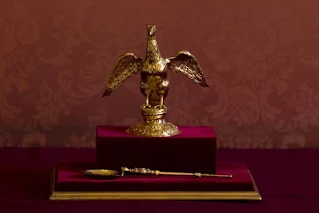 |
| Ampulla and Coronation Spoon |
Originally created by Robert Vyner for the 1661 coronation of King Charles II, the consecrated oil is poured through its beak.
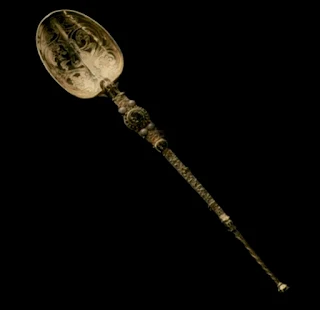 |
| The Coronation Spoon |
Meanwhile, the silver-gilt Coronation Spoon is the oldest object among the coronation regalia, dating back to at least 1349. It is also the only ever piece of Royal goldsmiths' work to survive from the 12th century since it once potentially belonged to King Henry II (1133-1189) or King Richard I (1157-1199).
The Sovereign's Scepter with Cross
Made for King Charles II's Coronation in 1661, the Sovereign's Scepter has been used for every British monarch's Coronation since Charles II. The current scepter has an exquisite Cullinan I diamond, the largest colorless ever-found diamond in the world.
In 1911, in time of the Coronation of King George V, the Crown Jeweler, Garrard, mounted the Cullinan I Diamond in the Scepter.
Bearer: Richard Scott, The 10th Duke of Buccleuch and Queensberry KT (Knight of the Thistle) - He was a British Peer from Scotland and a cousin of Prince Richard, the Duke of Gloucester
The Sovereign's Scepter with Dove
The Sovereign’s Scepter with Dove, made in 1661, symbolizes the monarch's spiritual role. It includes a gold, jewel-encrusted rod topped with an enameled dove, which represents the Holy Spirit.
 |
| Queen Elizabeth II carries two Sovereign Scepters at her Coronation |
Bearer: Baroness (Floella) Benjamin OM (Order of Merit) - a Trinidadian-British actress, author, politician, businesswoman, and TV Presenter. She is a Member of the House of Lords. She was given a life peerage in 2010.
The Sovereign's Orb
It symbolizes the monarch's power and the Christian world with its cross set on the gold globe. The globe is mounted with emeralds, rubies, and sapphires, surrounded by diamonds and pearls. The cross at the top of the Orb is mounted on a large amethyst.
 |
| The Orb, scepters, and St. Edward crown. Image: Royal Collection Trust |
At the end of the Coronation Ceremony, the Sovereign Scepter with cross and the Orb will be carried in the procession as the monarch leaves Westminster Abbey.
During the Coronation service, the Sovereign's Orb is placed in the right hand of the monarch, it is then placed on the high altar before the moment of crowning. This scepter symbolizes good governance.
Bearer: Dame Elizabeth Anionwu OM (Order of Merit). She is a British Nurse and a Healthcare Administrator
The Royal Mace
The ceremonial mace has been a symbol of royal authority for more than 1,000 years. It will be carried by peers ahead of the monarch during the procession into Westminster Abbey. The maces are also used during the State Opening of Parliament.
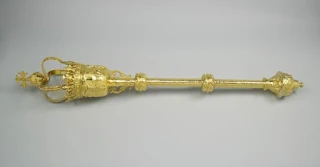 |
| Royal Mace. Photo: Royal Collection Trust |
The King's Coronation will use two maces that date back to the 17th century. They are made of silver gilt over oak. Buckingham Palace notes that they "are the ceremonial emblems of authority which are carried before the Sovereign at events such as the State Opening of Parliament."
The Sword of State
The Sword of State was made in the 17th century during the reign of King Charles II. It includes a steel blade with a silver-gilt hilt, enclosed in a wooden scabbard covered in velvet and bearing King William III's coat of arms. It was previously used at the 1969 Investiture of Charles, the Prince of Wales.
Bearer: Penny Mordaunt - a British politician who has been Leader of the House of Commons and Lord President of the Council since September 2022
 |
| From left: Sword of State, Sword of Temporal Justice, and Sword of Spiritual Justice ©Royal Collection Trust |
The Sword of Temporal Justice
The Sword of Temporal Justice, which signifies the monarch’s role as head of the Armed Forces, includes a steel blade tapered into a leaf-shaped point, a gilt-iron hilt with a wooden and wire-bound grip, and a velvet-covered leather scabbard.
It is one of three swords made for the 1626 coronation of King Charles I. During the coronation procession, the three swords are carried unsheathed and pointing upwards.
Bearer: The Lord Houghton of Richmond - General John Nicholas Reynolds Houghton, Baron Houghton of Richmond, is a retired senior British Army officer and former Chief of the Defense Staff (CDS) of the British Armed Forces.
The Sword of Spiritual Justice
The Sword of Spiritual Justice, which signifies the monarch as the defender of the faith, is the second of the three swords made for Charles I's coronation.
It includes a steel blade with a marker's mark at the top, a gilt-iron hilt with a wooden and wire-bound grip, and a velvet-covered scabbard.
Bearer: Lord Richards of Herstmonceux - General David Julian Richards, Baron Richards of Herstmonceux. He is a retired senior British Army officer who was formerly the Chief of the Defense Staff, the professional head of the British Armed Forces.
The Sword of Mercy or Curtana
The Sword of Mercy, which symbolizes the sovereign's mercy, is the third sword made for Charles I's coronation. It also features a steel blade, a gilt-iron hilt, and a velvet-covered scabbard.
Bearer: Air Chief Marshal the Lord Peach - Prime Minister's Special Envoy to the Balkans. He became a Crossbench Peer in the House of Lords in November 2022. Lord Peach was previously the most senior NATO military officer.
The Sword of Offering
The Sword of Offering, which was made in 1820 and first used at the coronation of King George IV, includes a steel blade mounted in gold and set with jewels, as well as a gold-covered leather scabbard. It was first used at the 1821 coronation of King George IV.
Bearer: Petty Officer Amy Taylor
St Edward's Staff
The original staff was thought to have once belonged to St Edward the Confessor and has since been recreated in 1660, though its original purpose is no longer remembered.
It features a tapering gold rod with decorative designs along the staff, topped with a cross above and a steel pike at the bottom.
Bearer: Baroness (Elizabeth) Manningham-Buller LG - She is considered the real-life M (portrayed by Judi Dench in James Bond films). Baroness Manningham-Buller is a retired British Intelligence Officer and was the Director General of MI5 (British Internal Security Service).
Spurs
The spurs that will be in use during the May 6 coronation were originally made in 1661 for Charles II. They are made of gold, leather, and velvet, and are meant to symbolize knighthood.
Bearers: Delaval Thomas Harold Astley, 23rd Baron Hastings, a British peer, actor, and farmer, and Michael Abney-Hastings, 15th Earl of LoudounLord Hastings, a British aristocrat who is currently living in Australia
Armills
Two gold bracelets, called the Armills, will be placed on the king's wrists during the May 6 coronation. Armills are said to be ancient symbols of knighthood and military leadership. They were made for the 1953 coronation of Queen Elizabeth II, replacing the previous 17th-century-era Armills.
The Sovereign's Ring
The Archbishop of Canterbury will place The Sovereign's Ring on the monarch's fourth finger during the coronation ceremony.
 |
| The Sovereign's Ring ©Royal Collection Trust |
The Sovereign's Ring is composed of a mixed-cut octagonal sapphire in a gold setting overlaid with four rectangular-cut and one square-cut rubies, butted together in a gold strip setting to form a cross, with a border of fourteen cushion-shaped diamonds and a diamond on each shoulder, with a gold hoop.
Until the 20th century, every monarch had a newly-made ring for their coronation. The current Sovereign's ring was made for William IV's 1831 coronation.
It was inherited by his widow, Queen Adelaide, who then bequeathed it to Queen Victoria. Every monarch has used William IV's coronation ring since King Edward VII's 1902 coronation.
Bearer: Brigadier Andrew Jackson - The Keeper of the Jewel House
St. Edward Crown
King Charles will be crowned with St Edward's Crown, which has traditionally been used as the coronation crown since the 17th century. The current St. Edward Crown was made for King Charles II in 1661 and was intended as a replacement for the original medieval crown, which was melted in 1649.
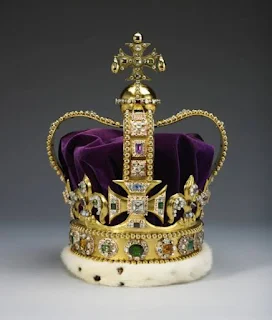 |
| St Edward Crown © Royal Collection Trust |
St Edward's Crown imitates the original design by including four crosses-pattée, four fleurs-de-lis, and two arches. The crown additionally includes a deep purple velvet cap, an ermine band, an orb, and cross topper, a solid gold frame, and plenty of gems such as rubies, amethysts, sapphires, garnet, topazes, and tourmalines.
St. Edward Crown is considered the most symbolic and sacred among Crown Jewels and will only be used to crown the British Sovereign during the Coronation Ceremony. Only four personalities are allowed to touch this crown: The Archbishop of Canterbury (who will crown the monarch), the British monarch, the Crown Jeweler (who will repair the crown) , and the Custodian of the Crown Jewels.
Bearer: General Sir Gordon Messenger, the Governor of HM Tower of London – Lord High Steward of England
Imperial State Crown
After the coronation service, the St Edward's Crown will be removed from King Charles's head and the monarch will wear the Imperial State Crown as he exits from Westminster Abbey.
 |
| Imperial State Crown ©Royal Collection Trust |
Imperial State Crown was last seen placed atop of Queen Elizabeth's coffin during her state funeral last September.
This crown was made for King George VI's coronation in 1937. It includes an openwork gold frame mounted with three large stones and set with 2,868 diamonds in silver mounts as well as 17 sapphires, 11 emeralds, and 269 pearls in gold mounts. It also features a fitted purple velvet cap and an ermine band.
The Imperial State Crown features the controversial Cullinan II, also known as the Second Star of Africa, which was mined in South Africa in 1905 and subsequently gifted to King Edward VII.
The Queen Consort's Coronation
The King's wife, Camilla, as a Queen Consort, will also be crowned with him but in a lesser ceremony. The Archbishop of Canterbury will place The Queen Consort's Ring on Her Majesty's finger.
The Queen's Consort Ring
This piece of jewelry, which was originally made for Queen Adelaide in 1831, features an octagonal mixed-cut ruby in a gold setting and is bordered by 14 cushion-shaped brilliants, plus 14 graduated mixed-cut rubies set on the gold shank.
 |
| The Queen Consort's Ring |
Since Queen Adelaide, three other Queen Consorts have been presented with the ring: Queen Alexandra, Queen Mary, and Queen Elizabeth (the mother of Elizabeth II). This ring is valued at a reported cost of £400,000, or $500,000.
Bearer: The Rt. Reverend and Rt Hon. Lord Chartres - Richard John Carew Chartres, Baron Chartres, a retired bishop of the Church of England
The Queen Consort’s Rod with Dove
Made in 1685 and mirroring the Sovereign's Scepter with Dove, it is intended to symbolize equity and mercy. The dove topper has a folded wing representing the Holy Spirit.
It is comprised of an ivory rod, joined by gold collars chased with acanthus leaves, surmounted by a gold monde enameled with the national emblems and a cross.
Bearer: Baroness (Helena) Kennedy of The Shaws
The Queen Consort’s Scepter with Cross
The Queen Consort's Scepter with Cross was made in 1685 for the coronation of Queen Mary, the consort of King James II. The original design included diamonds and precious stones but was later replaced with rock crystals.
 |
| Queen Consort's Scepter with cross © Royal Collection Trust |
The three sections of the gold rod are joined by collars mounted by rose-cut stones. Its topper features a monde set amid quartz-set petals, as well as a cross with rose-cut and shaped quartzes.
Bearer: General Sir Patrick Sanders
Queen Mary's Coronation Crown
Queen Camilla will be crowned using the Queen Mary's Coronation Crown. It was resized a month before to fit in Camilla's head.
 |
| Queen Mary's coronation crown |
However, the controversial Koh-I-Noor diamond which was placed in the center of the crown was removed due to the controversy of who is the rightful owner of this diamond. The Koh-I-Noor diamond has been removed and replaced with Queen Elizabeth II's Cullinan IV and V diamonds.\
Bearer: Charles Wellesley, the 9th Duke of Wellington - British Peer, Politician, and a Member of the House of Lords.
During the Coronation Service, the Regalia will be presented to Their Majesties. Those presenting have been chosen on the advice of the Government. Those presenting Regalia to His Majesty will be:
The Lord Carrington, Lord Great Chamberlain – Presenting the Spurs
The Lord (Syed) Kamall – Presenting the Armills
Baroness (Gillian) Merron – Presenting the Robe Royal
The Most Reverend John McDowell, the Church of Ireland Archbishop of Armagh – Presenting the Orb
Lord (Narendra) Patel KT – Presenting the Ring
Lord (Indarjit) Singh of Wimbledon – Presenting the Coronation Glove
The Most Reverend Mark Strange, Bishop of Moray, Ross and Caithness, and Episcopal Primus of Scotland – Presenting the Sceptre with Cross
The Most Reverend Andrew John, the Archbishop of Wales – Presenting the Sceptre with Dove
The Archbishop of Canterbury – Performing the crowning with St Edward’s Crown
Those presenting Regalia to Her Majesty will be:
The Rt. Reverend Rose Hudson-Wilkin CD, The Bishop of Dover – Presenting The Queen Consort's Rod
The Rt. Reverend and Rt Hon. Lord Chartres – Presenting The Queen Consort's Sceptre with Cross
Brigadier Andrew Jackson, The Keeper of the Jewel House at HM Tower of London – Presenting The Queen Consort's Ring
 |
| Their Majesties Coronation Rings ©Royal Collection Trust |
The Coronation Robes
As reported days ago, Their Majesties will wear two sets of Coronation Robes each. In keeping with His Majesty's principle of sustainability, he will re-wear his grandfather's, King George VI, Coronation Robes, with some additional personalized elements sewn on the fabrics.
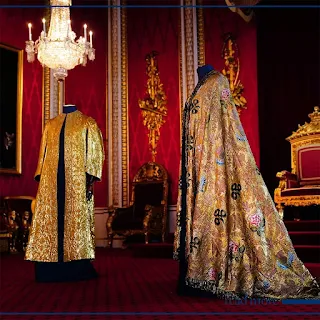 |
| Supertunica and Imperial Mantle ©Royal Collection Trust |
Robes of State are worn on arrival at Westminster Abbey, and Robes of Estate are worn on departure, following the Coronation Service, and are traditionally more personalized in design.
 |
| Lord Mountbatten, the uncle of Prince Philip, and Lady Mountbatten, attended Queen Elizabeth II's Coronation wearing their respective Coronation Robes and Coronets |
 |
| The 17-year-old Prince Edward, the Duke of Kent, and his mother, Princess Marina of Greece and Denmark at the Coronation of Queen Elizabeth II |
The Royal Family shares new images of this elaborate work showing the Royal School of Needlework’s embroidery team conserving The King’s Robe of State, which will be worn by His Majesty on arrival at Westminster Abbey, and The Queen Consort’s Robe of Estate, which will be worn after Her Majesty is crowned, on departure from Westminster Abbey.
His Majesty’s Robe of State (to be worn on arrival).
The King’s Robe of State is made of crimson velvet and previously worn by King George VI at the Coronation in 1937. In preparation for the Coronation Service, the velvet has been conserved by the Royal School of Needlework, with the lining and gold lace conserved by Ede and Ravenscroft.
Her Majesty’s Robe of State (to be worn on arrival)
The Robe of State to be worn by The Queen Consort was originally made for Queen Elizabeth II in 1953. The Robe is made of crimson velvet and has been conserved with adjustments made by robe makers at Ede and Ravenscroft ahead of the Coronation.
His Majesty’s Robe of Estate (to be worn on departure)
The King’s Robe of Estate is made of purple silk velvet embroidered in gold and was worn by King George VI in 1937. Robe makers at Ede and Ravenscroft have conserved and prepared the robe ahead of the Coronation.
Her Majesty’s Robe of Estate (to be worn on departure)
The Queen Consort’s new Robe of Estate was designed and hand embroidered by the Royal School of Needlework. The Robe itself was made by Ede and Ravenscroft.
The Royal School of Needlework’s design of the train draws on the themes of nature and the environment, featuring the national emblems of the United Kingdom, as well as paying tribute to His Majesty The King.
The Robe uses a rich purple velvet, chosen to match His Majesty’s Robe of Estate, and has been embroidered by the Royal School of Needlework using the Goldwork technique, with the design also incorporating Her Majesty’s cypher.
For the first time, insects including bees and a beetle feature on the Coronation Robe, drawing on the themes of nature and the environment and reflecting Their Majesties’ affection for the natural world.
In addition, there are a number of plants featured in the robe, all chosen for their personal associations. These include Lily of the Valley, which featured in Her Majesty’s wedding bouquet and was a favorite flower of Queen Elizabeth II; Myrtle, which represents hope; and Delphinium, one of The King’s favourite flowers and the birth flower of July, the birth month of The Queen Consort.
Also featured is the ‘Alchemilla Mollis’, known as Lady’s Mantle, which symbolizes love and comfort, Maidenhair Fern, which symbolises purity, and cornflowers, which represent love and tenderness. The Cornflower also helps to attract and encourage wildlife such as bees and butterflies.
The Supertunica
Also worn during the investiture – on top of the Supertunica — is the Robe Royal (Pallium Regale). Worn at the moment of crowning, this robe is embroidered with national symbols and imperial eagles crafted in silver thread decorate the corners of this four-square mantel. The Robe Royal takes on a priestly role: one of the divine nature of kingship.
The Imperial Mantle
This piece of clothing is worn over the Supertunica and is more similar in design to a robe and is the oldest vestment ever used by the monarch in the Coronation.
Originally made for King George IV's Coronation in 1821. It has been worn by the Windsor monarchs during their respective Coronations - King George V, King George VI, and Queen Elizabeth II.

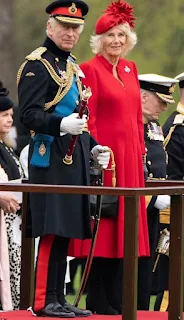
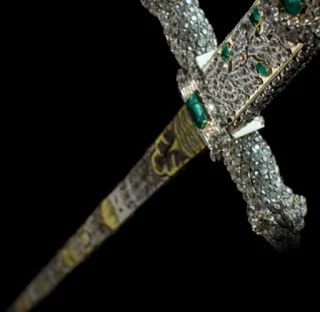
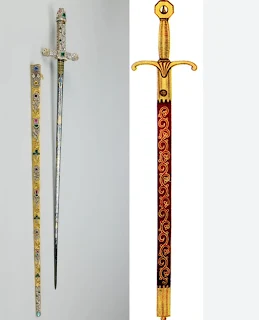









0 Comments